Sharlyn J. Lauby's Blog, page 101
March 22, 2019
Job Posting Semantics Are Important
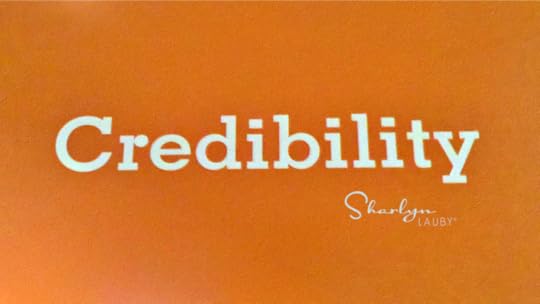
If you’re not aware, there is a community for eLearning professionals called the eLearning Guild. They provide education, research, a job board and much more. I’m mentioning this for a couple of reasons. First, if you’re trying to learn more about eLearning, this could be a place for you to do so. Second, if you’re looking for an eLearning professional, this might be a place to find one.
Lastly, if you are trying to retain eLearning professionals, this is someplace to consider joining.
Jane Bozarth, director of research at eLearning Guild, recently shared with me her report on “eLearning Salary & Compensation: Advice for Workers, Recruiters, and Hiring Managers”. The report outlines average salaries, by title, education, and certification for the eLearning profession. It’s a great read for organizations and individuals about what is currently happening within the profession (and it’s FREE to HR Bartender readers!)
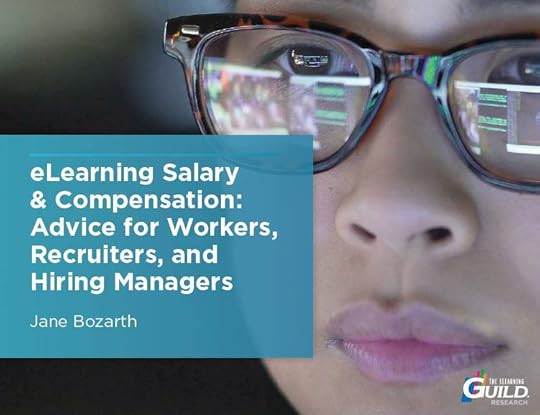
What struck me though about the report was the level of clarification needed for roles in this area. For example, when it comes to eLearning professionals, does the organization want someone with video and audio production background? And if so, how much? Should the candidate have experience with content curation? What about mobile app design?
You get my point. When recruiters are conducting a search for eLearning professionals, they need to have the right level of detail to draft a clear job posting. Words like “eLearning” might not be enough.
This could explain why some organizations are so frustrated with their recruiting strategies. If job postings aren’t clear enough, the result will be a lot of applicants believing they’re qualified when the organization thinks they’re not.
Take this thinking to the other job postings being crafted. Are organizations looking for “accounting” professions when they really want someone with payroll experience? Or is a company advertising for a “sales representative” instead of a candidate with proven cold-calling skills? The quality of the job posting will have a direct bearing on the applicant flow received.
Take some time during the recruiting strategy meeting (aka “intake” meeting) to talk semantics. Ask hiring managers if they feel some wordsmithing would yield candidates that are more aligned with the actual duties of the job.
Conduct A/B testing if possible. Look at older job postings. If feasible, make a change and track it. You know what your applicant flow was for the prior posting. Now see if that word change or clarification helps produce more qualified applicants.
Look to professional associations for information. One last thing to consider when developing job postings – professional associations, like the eLearning Guild, are doing the homework for you. That’s definitely worth the cost of membership.
While I believe organizations need to spice up their job postings to stand out in the crowd, it’s important that “spicing up” doesn’t translate to “watering down” the job requirements. Because it will impact who applies, who gets hired, and ultimately the organization’s bottom-line.
The post Job Posting Semantics Are Important appeared first on hr bartender.






March 21, 2019
Legislative Update: New FLSA Overtime Changes Proposed

One of the essential components of our human resources role is compliance. Some people might say it’s not very sexy, but that doesn’t matter, because it’s important. And as much as the business doesn’t like hearing about compliance matters, they really don’t like hearing when the company isn’t in compliance.
So, when major legislation changes are on the horizon, it’s important to take notice. If you’re a member of the Society for Human Resource Management (SHRM), you’ve probably received several notices lately about proposed changes to the Fair Labor Standards Act (FLSA). Here are a few articles about the proposed rule:
Notice of Proposed Rulemaking: Overtime Update [U.S. Department of Labor]
Department of Labor Announces New Proposed Overtime Rule [Paycom blog]
Proposed Overtime Rule Covers More Workers [SHRM]
To understand what’s going on, I reached out to Matt Paque, vice president of legal and compliance at Paycom. Just a reminder that Matt’s comments should not be construed as legal advice or as pertaining to any specific factual situations. He has a full-time job and is doing this as a giveback to the profession. If you have specific or detailed questions, go ahead and address directly with your friendly neighborhood labor attorney.
Matt, let’s start with some history. Back in 2016, the government proposed some FLSA overtime changes. Did those happen? I thought that pretty much fizzled with the change in administrations.

[Paque] The proposed FLSA changes by the U.S. Department of Labor under the Obama administration were invalidated in 2017 when Judge Amos Mazzan of the Eastern District of Texas determined that the 2016 Final Rule issued by the U.S. Department of Labor, which increased the minimum salary threshold to $47,476, was not a valid action by the agency.
So, all the work we did back in 2016 didn’t happen. Now there’s a new proposal. I know you don’t have a crystal ball, but what are the chances that this is really going to happen (versus another false alarm for employers)?
[Paque] Currently, this is only a proposed rule, so employers do not need to make efforts to comply just yet. However, it is a good idea to take steps toward understanding just how substantially these proposed salary levels could cost your business.
How different is the 2019 proposal from 2016? My point being, if I have my implementation and communications plan from 2016 sitting around the office, can I dust it off and just pick up where I left off?
[Paque] The current changes differ slightly, with the most significant difference being the minimum salary threshold.
If I shredded my 2016 implementation plan and need to start over, what are 2-3 things I need to do this time around for starters?
[Paque] Employers should consider two things:
Evaluating how many employees earn an annual salary below the new, proposed levels – $35,308 annually for standard, white-collar employees, and $147,414 annually for highly compensated employees. Understanding how much overtime is earned by the employees who are making less than the proposed levels in #1.
Knowing these two things will help you estimate just how much a potential increase could cost your business.

Last question, since this is still just a proposal, where I can stay on top of what’s happening?
[Paque] You can visit the Paycom blog for the latest on overtime expansion or check the U.S. Department of Labor’s website.
I want to extend a huge thanks to Matt for dropping everything and sharing with us the latest about this important piece of proposed legislation. While it’s still just a proposal, this is the second time in less than five years that we’ve seen a conversation about overtime. Organizations will want to watch the conversation.
Image captured by Sharlyn Lauby after speaking at the SHRM Annual Conference in Washington, DC
The post Legislative Update: New FLSA Overtime Changes Proposed appeared first on hr bartender.






March 19, 2019
11 Tips for SHRM Annual Conference Attendees – #SHRM19

If you’re in the human resources profession, then you know the Society for Human Resource Management (SHRM) Annual Conference is fast approaching. This year’s event will be held June 23-26, 2019 in one of my favorite places, Las Vegas. This is a must-go event for me and I’m not just saying that because it’s in Vegas. I’m really looking forward to the educational opportunities, seeing fellow bloggers that I interact with on Facebook and Twitter throughout the year, and professionals who I worked with as a SHRM volunteer leader.
If you’ve never been to a SHRM Annual Conference before or it’s been a few years, let me tell you – it’s a big conference. HUGE! We’re talking tens of thousands of people, but don’t let that intimidate you. The ginormity (it’s a word, right?!) of the event also means the conference offers something for everyone . . . if you prepare yourself properly. So, here’s my annual list of tips for people who are planning to attend:
BEFORE YOU GO
Download the conference app. If you’re looking for copies of handouts and special announcements, it will all be in the app. You could wait and do it onsite. There will be WiFi during the conference, but it’s not like your WiFi at the office or home. So, download the SHRM Annual Conference app before you leave. It will save your data plan for more important stuff.Download the SHRM Certification app before you leave. If you are a certified professional and have an iPhone/iPad, make life easy on yourself and download the SHRM Certification mobile app. You can track recertification points as you earn them.Bring a shipping label to mail stuff home to yourself. The expo hall is also the home to all kinds of conference swag. If you’re concerned about your luggage hitting the weight limit, just print off a shipping label and mail stuff home. If you don’t use it, fine. At least you have a backup plan.Start following the Twitter stream – #SHRM19. I know that not everyone is a fan of Twitter, but conferences and events are one of the things Twitter continues to do well. Dust off your Twitter account before you leave and save the hashtag. It’s a way to follow the action. You might get some ideas about a session to attend, a book to purchase, or someplace fun to meet and eat.
ON THE PLANE
Plan your schedule but save some time for impromptu meetings. There’s a delicate balance between sticking to a schedule and taking advantage of last-minute opportunities. If you’re a scheduling freak like me, I block off free time to use for last minute meetings (or sneaking off to Starbucks! Or maybe a burger run!!)Some of the best sessions are the early ones! I know, it’s Las Vegas and the trip wouldn’t be complete without a little bit of partying. But I can tell you from experience, some of the best sessions are early in the morning. I know I’ll be grabbing a venti dirty chai to make the “Work Inspired: How to Build an Organization Where Everyone Loves to Work” session at 7:15a on Monday, June 24.Check out at least one session on the Smart Stage. SHRM has their own version of TED Talks – it’s called the Smart Stage. The sessions are short (less than 20 minutes) and they take on a more conversational tone. I’m hoping to stop by Louis Lessig’s session on “Understanding Cybersecurity: The New Role of HR in Protecting Your Organization” on Monday, June 24 at 12:20p.
WHILE YOU’RE THERE
Use the bookstore as a central meeting location. Every time I’m at a conference, there’s always at least one moment where someone says, “Where should we meet?” The answer? Right in front of the SHRM Store. Works every time. And, while you’re waiting, you can check out the excellent books and resources they have available.Take care of yourself. Drink plenty of water. Yes, I know that everyonesays this everyyear but it’s true. Vegas in June will be hot, hot, and hot. Wear comfy shoes. Bring lip balm and skin moisturizer. The conference is supposed to energize you. And if that also means finding a little quiet time for yourself, do it too!Pay it forward with party tickets. Lionel Richie was recently announced as the entertainment for the Tuesday night party. Some people will love this choice (and others not so much). If you’re not going to use your Tuesday night ticket, give it to someone who will use it. At some point, you’ll want someone to do that for you.EXPO! Last but certainly not least, I cannot say enough how important it is to visit the vendors in the expo hall. These organizations are the reason that SHRM can continue to secure awesome speakers and keep registration prices low. Exhibitors and sponsors offset those costs. So, walk around the expo and check out the latest HR products and services.
The SHRM Annual Conference and Expo offers a lot of education, networking, and fun for professionals looking to stay current with what’s happening in the profession. And I’m not just saying that because I’m going. Every year, it continues to amaze me. Hope you can join us in Vegas Baby!
P.S. If you want to get a jump-start on your learning experience, join me for a pre-conference educational program. I’ll be facilitating “Talent Acquisition: Creating Your Organization’s Strategy” starting Saturday, June 22, 2019. For more details, check out the SHRM Annual Conference site. The program is pre-approved for professional development credit and is part of the requirements for the Talent Acquisition Specialty Credential.
Image captured by Sharlyn Lauby after speaking at the SHRM Annual Conference in Las Vegas, NV
The post 11 Tips for SHRM Annual Conference Attendees – #SHRM19 appeared first on hr bartender.






March 17, 2019
Social Media Background Checks: Are They Okay – Ask #HR Bartender

I knew that today’s title will get your attention.
I’ve been waiting for someone to send me this question! I’m sure this reader’s note will resonate with many:
I have a question regarding social media. Last year, we came across a candidate who had a number of recent social media posts expressing racially charged views. We decided not to move this candidate along in the selection process as these posts didn’t reflect our company’s values. Our thought process was:
1) They’re a reflection of our brand and we don’t want to be associated with those views and,
2) Those views probably wouldn’t be good for employee morale.
Were we wrong to use social media in this way? Is there a legal issue with making decisions like this in the future? Would appreciate your insight!
To help us understand the nuances of this issue, I asked our friend Heather Bussing if she would lend us her valued experience and thankfully she said “yes”. Heather is an employment attorney and regular contributor at HR Examiner. She’s helped us on several occasions and this post about the importance of job references is still one of my favorites.
Don’t forget that Heather’s comments shouldn’t be construed as legal advice or as pertaining to any specific factual situations. If you have detailed questions, they should be addressed with your friendly neighborhood labor and employment attorney.
Heather, thanks for helping us understand this issue. Let’s address THE burning question that everyone wants to know. Is it okay to Google or search social media for candidate information? Why or why not?

[Bussing] Generally, it is okay for potential employers to look at anyone’s public social media. It happens all the time. But if the employer obtains the report from someone outside the organization, the Fair Credit Reporting Act (FCRA) applies and you have to give the candidate notice you are doing a background check and get their consent. ‘Outside the organization’ includes third party recruiters, background checking companies, and can include technology that checks and reports on a candidate’s public social media.
It is illegal under the FCRA and discrimination laws to use the information you find to discriminate against someone because of a protected class. So, if the information that makes you uncomfortable is related to religion, race, gender, or other protected classes, be careful before using it as the basis of an employment decision. Politics is a big issue right now, and political affiliation or views can also be a protected class (e.g. California, New York, District of Columbia).
In this situation, the organization discovered some information they considered rather alarming. Is there another way for the company to discover this?
[Bussing] Often background checkers will report on public social media postings. It’s possible someone’s racist or sexist views may show up in a conversation with a reference or even during an interview.
It used to be that people kept views on religion, gender, race, and sexuality fairly private. But that has changed in the past few years with people feeling more comfortable pronouncing their views in public.
In this case, the reader said the disturbing information was ‘racially charged views’. Without more information it’s hard to know whether it would be discrimination to reject the candidate based on this. But it appears that the concern is that person would discriminate against and potentially harass others on the job based on their views about race. If the social media posts advocate discrimination based on race and it is reasonable to believe the candidate would bring those views to work, then I would advise not hiring the person because of the reasons stated – the organization does not want to be affiliated with it, it would be potentially disruptive to the work environment, and would create potential liability for the company.
If an organization sees something on social media that concerns them, are they obligated to ask the candidate about it?
[Bussing] If the information comes up as part of a background check covered by the FCRA, then they have to give the person a copy of the information, say it was the basis of their decision, and allow them to correct or clarify. But they still don’t have to hire the person.
If the information is not subject to the FCRA, then the employer does not need to ask the person about it.
I know a lot of HR departments that don’t search a candidate’s social media accounts, but they suspect that their hiring managers are. How can HR address the issue with managers?
[Bussing] It’s not the searching that’s the problem. It’s the learning information about someone that could create a claim of discrimination because the person turns out to be pregnant, disabled, older, or some other factor that is protected by law. If the organization doesn’t know what information is the basis for selecting candidates, then it’s hard to manage against bias.
But the truth is that no matter how hard we try to create neutral, nonbiased candidate selection processes, all our biases flow back in when the person arrives for the interview. So, it’s also essential to track your data to see who gets hired, what the candidate pool looks like at various stages, and what is happening if there seem to be issues. This data is all discoverable in a lawsuit, so it’s better to understand it and make corrections before bias creeps in.
One last question and this one is for candidates. If a job seeker has said a few things on social media that they now regret, is there something they should do so it doesn’t ruin their chances for a new job opportunity?
[Bussing] There are two approaches and I have talked to job seekers who use each of them and feel strongly it’s the right approach:
The first is ‘the best light’ approach. These job seekers go through their public social feeds and delete anything that could be misinterpreted or make them look bad. They also lock down their privacy controls on everything else so it’s harder for people to discover information about them online. The idea is to create a favorable picture to anyone who might be looking. The drawback is that you can come off as fake or trying too hard.
The second is the ‘filter’ approach. These job seekers believe that an employer who doesn’t like their views or online personality probably won’t be a place they would want to work anyway. Being yourself online saves everyone a lot of time and energy because you don’t want to work for someone who isn’t going to like you.
This is the foundation of bringing your whole self to work and many views of inclusion. But employers are still not required to hire people they believe will be violent or harass or discriminate against others when the person’s views would violate employment or other laws.
A HUGE thanks to Heather for sharing her knowledge with us. This isn’t an easy subject for job seekers or organizations because there’s a significant gray area to work within. I believe Heather’s comments about transparency and authenticity are spot on.
Social media isn’t going away anytime in the near future. Organizations need to have a formal social media policy that everyone is aware of and follows.
Image captured by Sharlyn Lauby while exploring the streets of Fort Lauderdale, FL
The post Social Media Background Checks: Are They Okay – Ask #HR Bartender appeared first on hr bartender.






March 15, 2019
Organizational Leaders Must Understand Their Workforce – Friday Distraction
(Editor’s Note: Today’s post is brought to you by our friends at Kronos , a leading provider of workforce management and human capital management cloud solutions. Join me for a special SHRM podcast with Kronos CEO Aron Ain as we chat about “ Work Inspired: How to Build an Organization Where Everyone Loves to Work ”. Enjoy the article!)
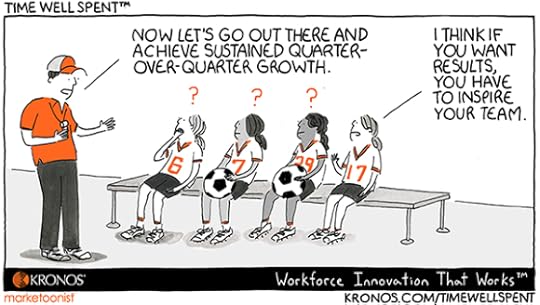
We spend a lot of time telling individuals that the way to get ahead in their career is by being able to speak the language of business. Know business acumen. Talk like the C-Suite. And all of that is true.
But today’s Time Well Spent cartoon from our friends at Kronos reminded me that as leaders, we also need to be able to speak like our workforce. We need to empathize with them and address them in a way they understand. That does not mean talking down or dumbing down the message. It means being able to relate to our workforce.
For example, if a manager is making $100,000/year and the majority of the people in their department make $15.00/hour (or basically $31,200/year), there’s a pretty big disparity there. How is that manager talking about career development? Are they telling employees they should pay to attend classes to improve their skills, knowing they might not have the same amount of discretionary income?
Now for a moment, let’s put the money conversation to the side. In the cartoon, the coach is talking about “sustained quarter-over-quarter growth”. And the players have no clue what the coach is talking about. Managers and leaders need to talk about performance in terms that employees understand. Does the organization share the company’s profit and loss statement with employees? Do employees know what the key performance metrics are for the company?
Finally, one more example. Organizations do better when they build diverse workforces. But obviously, diverse workforces are … diverse. Employees will have different backgrounds and experiences. Everyone in the organization needs to be open to learning about those differences. For instance, Mr. Bartender and I don’t have children. I’ve worked with plenty of people who do. As a manager and a leader, I needed to learn what it’s like to be a working parent so I could be more in tune with my team and co-workers.
When we discuss learning about the business, we’re not just talking about learning the numbers. And when we say that managers need to speak the language of business, it’s not just about using a bunch of financial jargon. It’s about understanding your audience: who they are, what motivates them, and how to build a positive working relationship with them.
The post Organizational Leaders Must Understand Their Workforce – Friday Distraction appeared first on hr bartender.






March 14, 2019
3 Tools to Help You Manage Your Digital Life

I recently published a list of cybersecurity resources from TechCrunch and Google. If you haven’t seen them, it’s worth checking out.
Technology continues to fill our lives, which means we need to find ways to manage it. I’m not talking about taking digital vacations, although establishing boundaries is a good idea. When we use technology, we open ourselves up to risk. Even when we do all of the right things, it’s possible we will have personal information exposed. In today’s society, it could make sense to evaluate whether or not you need some tools to manage your digital life.
For example, here are three tools that I’ve added to my life.
Password Managers
This is a nice read from Consumer Reports on “Everything You Need to Know About Password Managers”.
And this article from CNET will give you some suggestions for “The Best Password Managers of 2019”. Personally, Mr. Bartender and I use LastPass and have been very happy with their product. They offer a family plan so you can make sure that a designated person can access your information in case of an emergency.
While it’s not a exactly a password manager, I also recently purchased a Google Titan Security Key. This device provides a super-duper level of two-factor authentication to your accounts. I must admit, I’m still trying to figure it out, but I believe it is worth experimenting with.
Identity Theft Protection Services
It’s sad to say that in today’s world we have to think about this…but we have to think about this. Identity Theft is an issue. A big issue. According to a study published on ZDNet, around 15 million people in the U.S. have been impacted by fraud. To safeguard yourself, you have two options: you can do this yourself OR you can subscribe to a service. A third option would be waiting for a company to provide you with the service for free after your information has been compromised. (Please detect the cynicism in my last sentence.) I found this article on Nerdwallet that could help you decide “Do You Need Identity Theft Protection Services?”.
CNET also put together a directory of ID monitoring services in their article “The Best identity Theft Monitoring Services for 2019”.
Virtual Private Network
A virtual private network (VPN) is designed to protect your private web traffic from being snooped by outside entities. The purpose isn’t because someone is doing something sinister. But let’s be real, it’s kinda creepy to know that somebody could be snooping around in my web traffic even if it’s nothing more than cute lemur pictures, shoe sales, and Randy Rainbow videos.
If using a VPN interests you, this article from CNET on the “Best VPN Services of 2019” might be helpful.
I really don’t like being cynical about the use of technology, but I do think it’s important to be realistic. Technology isn’t going away any time soon. We have to be responsible technology users which means finding tools to help us manage our digital lives.
Do you need to do these things? Maybe not. Personally, I’m finding this is one of those topics where I regularly ask myself, “Can I do it? Yep. Is this the best use of my time? Not really.” Maybe I need to find some tools to help.
Image captured by Sharlyn Lauby while exploring the streets of Hollywood, FL
The post 3 Tools to Help You Manage Your Digital Life appeared first on hr bartender.






March 12, 2019
How to Get Your First Job In Human Resources – Ask #HR Bartender
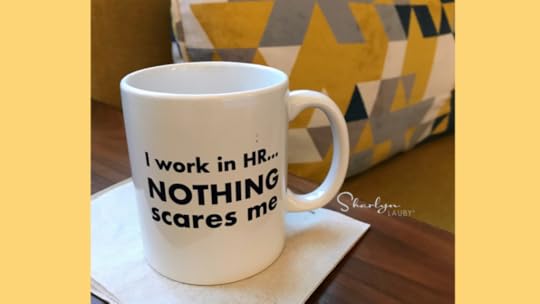
This is a great reader question about how to start a human resources career.
Hey Sharlyn, I really enjoy your blog and had a question for you. I’m currently a college senior looking to break into the HR field. What type of employment would offer the best opportunity to learn and grow? I’ve been thinking about recruitment or inclusion and diversity work. Any advice would be appreciated! Thank you!
My start in human resources wasn’t through the normal career path. After an auto accident left me physically unable to do my job, the company I worked for transferred me into human resources. And the company provided me with training to be successful. So, I certainly wouldn’t recommend that anyone go through what I did to get into HR.
But I reached out to a friend to get his insights. Steve Browne, SHRM-SCP has devoted his career to the profession. He’s currently vice president of human resources for LaRosa’s, Inc., a regional pizzeria restaurant chain based in Ohio. And he’s on the board of directors for the Society for Human Resource Management (SHRM). I’ve had the pleasure of knowing Steve for years and was delighted he agreed to share his thoughts with us.
Steve, based on your experience, how difficult is it to enter the HR field?

[Browne] There are a few ways to look at this. I think entering an aspect of HR is fairly easy. Many people start out in recruiting. This is a great way to get experience and learn about the nuances of working with people, sourcing talent, and adding folks to an organization to make them better.
Getting directly into the field of HR as a generalist is harder. It shouldn’t be, but it is. It’s ironic that we expect ‘experience’ to be a generalist, but we are hesitant to give people new to HR a chance. We end up doing the same thing other professions do.
I’d love to see HR be more open in having new, interested people join the profession willingly and intentionally. Too often we hear about people ‘falling into’ HR. That works because many people have ‘enjoyed the fall’. It would be even better though if HR was a choice and not something that happened by chance.
Let’s expand on the generalist and specialist aspect. For people thinking about an HR career, would you suggest they start as a specialist or a generalist?
[Browne] The key here is that a person needs to know themselves first. Having a solid grasp of your strengths, your personality, and your approach is needed before pursuing a specialist or generalist role. Self-awareness is far more important for a person at any stage of their career versus picking one type or another.
Personally, I enjoy the generalist side of HR because I need to have a broad base of experiences and exposure to a variety of people at all levels of the company in order to feel fulfilled. A specialist is someone willing to be more focused and narrow in their role. Both generalists and specialists are valuable ways to practice HR.
You mentioned that it could be easier if someone started off as a specialist. If someone decided to do that, how should they go about choosing their area of expertise?
[Browne] Ask yourself – what fills your bucket? If you’re comfortable in a data/numbers arena, then look at roles that range from HR data analytics to compensation analyst. If you’re more adept at explaining skills and work to others, consider organizational development and/or learning and development roles.
What’s key here, and really in any role, is asking, ‘Can I leverage my strengths in order to add value to the company and the employees?’ When you work from your strengths, you’re truly giving your best in all of your endeavors.
If someone could do only one thing a year to better their HR knowledge, what should they consider?
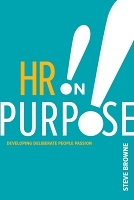
[Browne] Read. I mean it. Be a voracious reader. It’s been said ‘Leaders are readers.’ Being a continuous learner is key because the field is evolving on a regular basis. It’s not enough to learn the HR101 skills and then stay put. Subscribe to blogs and read books about HR, business, creativity, etc. You can take most books and pull information/experiences out that can relate to practicing HR.
With podcasts now being so popular, I’d add subscribing and listening to them as well. It’s another way to stay fresh and relevant. It’s imperative that you keep growing personally and professionally.
Last question. When you think back on your HR career, what’s the one thing you know now that you wish you knew when you started?
[Browne] I wish someone had told me the power of having a network of peers. No one explained that having other professional connections was important. Networking is a foundational business skill, and not just a job searching ploy. Having peers you can go to with questions is priceless. You can get so much more accomplished by reaching out to others instead of trying to gut it out alone. HR is better when you a part of a community.
My thanks to Steve for sharing his experiences with us. If you would like to learn more about his HR philosophies, check out his blog Everyday People and pick up a copy of his best-selling book “HR on Purpose!!”. Believe me when I say you won’t be disappointed.
The good news is there are lots of different ways to enter the human resources profession. They all involve having an understanding of ourselves and how we can bring value to organizations.
Image capture by Sharlyn Lauby while exploring the streets of San Diego, CA
The post How to Get Your First Job In Human Resources – Ask #HR Bartender appeared first on hr bartender.






March 10, 2019
Hold Managers Accountable For Developing Talent
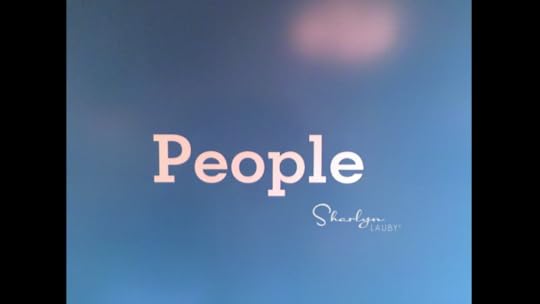
I’ve mentioned several times that I believe a manager’s primary job is to hire and train their replacement. Managers shouldn’t be threatened by this because it’s not something that happens right away. Developing talent takes time.
For example, let’s say the CEO comes into your office this afternoon and says, “I want to put together a team to work on our next big product. It’s a super-secret project, but I want our best performers. Give me a list of names to consider ASAP!” At first glance, you’re thinking, “No problem. We have plenty of great performers.”
But then reality sets in. If your managers haven’t been out there developing their talent, then they don’t have anyone to delegate to. Which means that if they were assigned to the CEO’s project, their team would suffer. That’s not a win for the manager, the department, or the organization.
But I can see the manager’s point of view too. The company tells them that they need to develop employees then fills their plate with all sorts of other projects. Developing employees often moves way down on the priority list.
The way organizations and managers can shift the focus back to employee development is by making it part of the manager’s performance expectations (i.e. part of their performance review). And let’s take it one step further, it should be a part of the learning and development (L&D) department metrics.
Learning and development teams should have a metric that reflects the ratio of employees who receive training versus development. I like to define training as learning related to the job you have and development as learning towards a future role. It should be easy to track – – when an employee attends a learning event, is it training or development? That will tell the organization how much talent development is taking place.
Managers should be held accountable for giving their employees development opportunities. Managers should be able to set a goal of scheduling every employee for a certain number of development sessions each year. My guess is that, right now, employees are asked to complete a minimum number of training hours each year. Extend that to include a minimum number of development hours.
Organizationscould take this one step further and ask employees to identify one area of development they would like to learn more about during the upcoming year. It could be a goal that managers and employees agree upon. Not only does this help the organization develop future talent but it can start a conversation about where employees would like to be (from a career perspective) in the years to come.
Many organizations don’t want to create formal replacement or succession plans. I get it. That doesn’t mean they shouldn’t have any plans when it comes to future staffing. Holding everyone accountable for development can keep efforts moving in a positive direction, even when formal plans aren’t being made.
In today’s job market, it’s possible that the candidates being hired need training and development. Organizations should set aside resources for this purpose. Effective talent management and development is the key to future organizational growth.
Image captured by Sharlyn Lauby after speaking at the ATD International Conference in San Diego, CA
The post Hold Managers Accountable For Developing Talent appeared first on hr bartender.






March 8, 2019
Find a Reason to Get Excited and Be Productive – Friday Distraction
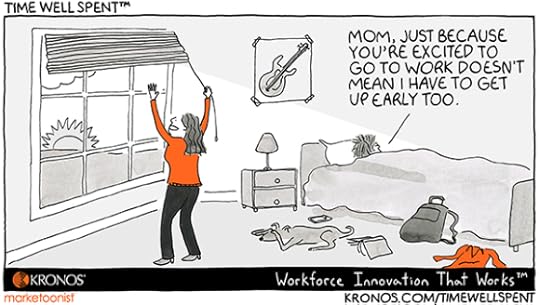
I’ve always been a morning person. And luckily, Mr. Bartender is also a morning person. We start our days early and neither one of us is much for staying up late. So, I couldn’t help but laugh at this Time Well Spent from our friends at Kronos. It can be a challenge when one person is an early bird and the other is a late riser.
Not only can it be a challenge at home, but it can be a challenge at work too. Being a morning person, I would show up at the office and be ready to tackle the day. I’ve worked with some people who, when they arrived at work, needed to immediately get some coffee, and you didn’t want to speak with them until around 10a. Somedays 11a. ha.ha.
But there was one thing that, regardless of our morning disposition, we could agree on, that’s getting excited about what we’re working on. Just because some people needed a few extra moments in the morning didn’t mean they were less excited about the projects we were working on. Same goes for me when it came to working evenings. Just because I was showing signs of being tired, it didn’t mean I thought the project was boring.
Understand your optimal working arrangements and share them with your team. Think about those times when you’re at your most productive state. What does that look like? Take a moment to catalog what being productive looks like for you. Then make sure to create those conditions in your work environment. If you haven’t created a personal user manual, this might be perfect information to include. And share it with your boss and co-workers.
Figure out how to keep your energy levels up when asked to work outside of your optimal zone. Once you understand your most productive state. Do the same for the opposite. Think about when you’re least productive. What does it look like? And when you have to work in those conditions, how can you still maintain productivity? While we would all like to always work in our most productive environment, that’s not realistic. We do need to know how to adapt.
Plan projects so all team members can work and can get in their flow as much as possible. Managers and project team leaders should be aware of how their teams like to work and build a project schedule that allows everyone to be their most productive. Oh sure, there will be times when we all have to flex. But that should be the exception and not the rule.
Organizations want employees to be productive. It helps the organization achieve their goals. Managers should be aware of what it takes for their teams to be productive and create a work environment that allows them to get excited about the work. Give employees a reason to get up in the morning – whether it’s at 6a or 9a (or even later).
The post Find a Reason to Get Excited and Be Productive – Friday Distraction appeared first on hr bartender.






March 7, 2019
5 Rules to Effectively Manage Your Email
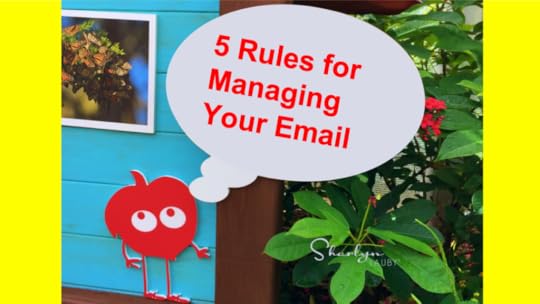
I recently received a note on Twitter asking, “What’s your ‘managing email’ process?” I love this question! Not because I’m the world’s leading expert on email, because I’m not. But I do spend a lot of time on email and I’m happy to share my system if it can help someone out.
The reason I love the question is because email fascinates me. IMHO, email is one of those things that’s been around forever but doesn’t have a lot of “etched in stone” rules. According to Wikipedia, email has been around since the 1960’s. And yet, I still get emails written with either no punctuation or ALL CAPS. So, I think there’s a lot of learning and sharing we can do with email to make it a better communication medium. And who wouldn’t want that?
All that being said, let’s get back to the question. Because I believe that I do a fairly good job of managing my email, here how I manage my inbox:
Focus on sending clear, concise emails. Managing your email is as much about sending as receiving. The secret to sending a good message is trying to anticipate the receiver’s needs. For example, if you get an email that says, “I’d like to set up a phone call to discuss the ABC account.” Then the reply shouldn’t be “That’s great, let’s do it.” Add an extra sentence that says, “I’m available on Thursday afternoon.” Otherwise, you will add 2-3 more emails to your inbox trying to figure out when to have the meeting.Use folders to quickly access older emails. While the search feature in email is terrific, I have folders for projects I’m working on so I can quickly search for emails. Same for advisory boards and groups I belong to. It’s easy to drag an email over to the folder for future reference. And it’s come in handy a few times! I also have a folder where I store receipts from online purchases in case I need to follow-up with a company. And once a year, I edit these folders, so they don’t get too out of control.Develop rules. I don’t need to see every email the second it arrives. So certain senders and subjects are automatically sent to a unique folder for later viewing. This is terrific for the emails I receive from social media sites and newsletters. I go in that folder daily to review and read the emails. Honestly, I wonder if I would be hitting the delete button more often if they showed up directly in my inbox. The reverse is also true. I have a folder for high priority senders, so their emails don’t get lost in the shuffle.Set a personal standard for replies. I conducted a focus group years ago where participants said 24 hours was a reasonable time to wait for an email reply. You can decide for yourself if that makes sense. There are also self-proclaimed email experts who will tell you that you should answer emails once a day. The last thing I want to do is tell someone when to answer emails. But I will say that everyone deserves respect and a response. Figure out a system that works for you. Or you will get extra emails asking, “Did you see my original email?” Please note that this does not apply to the following category of email.Have an effective spam filter. While most email software has a pretty good filtering system, it’s not perfect. If you need a little extra oomph, consider an add-in. A quick Google search will yield you pages of articles about the best email spam filters – some free and others with a small fee. Just don’t forget to glance at your junk folder every once in a while. Not checking your spam / junk folder can save extra emails asking, “Did you check your spam folder for the instructions?”
BONUS! One more thing to consider when it comes to email is your email software. I know at work, you might not have a choice regarding the type of email you use. But at home, you could find using a different email client makes you more productive, which translates into less frustration and better email management.
Do you have a tip for managing your email? Leave us a comment. I think this is one of those posts where we could get a good list of email strategies going…
Image captured by Sharlyn Lauby while exploring the exhibits at Walt Disney World, FL
The post 5 Rules to Effectively Manage Your Email appeared first on hr bartender.






Sharlyn J. Lauby's Blog
- Sharlyn J. Lauby's profile
- 10 followers



